Happy holidays! Whether it be fleece, roving, or yarn, you cozy up to, I hope everyone is enjoying the season with a bit of warm fiber. In between making gifts, decorating, baking/cooking and shopping (and maybe even guests this year), make sure you give a little free-fiber-time to yourself. Enjoy the twists and the stitches. It feels especially good in these cold months. I know I’ll be cozying up with some fleece in my lap for sorting and batts in my hands for spinning. In between making hats and wreaths for my December 4th Wimberley Market Days, of course.

Without putting too much emphasis on shopping, I’ll quickly point out that today is Small Business Saturday. It’s a wonderful thing to have declared a day for supporting small business in this mad-rush big shopping time of the year. Shopping small businesses supports people and local communities directly. Shop small businesses when and where you can all year long. It’s a good thang.
I hope each of you find the warmth of the season in all the ways that make you happy.

Today is the first day of autumn – the Autumnal Equinox. It’s one of two days per year there are equal amounts of day light and night. Starting tomorrow, the sun will start rising later and the darkness of night will ease in a little earlier. Shorter cooler Autumn days are here.
I can see and feel the change here in Austin today. I’m not sure I’ve ever been more aware of this change than I am this year, today. As I hopped out of the car this morning for our daily school drop-off, there was a breeze, an almost cool breeze! Our summers hover around 100 degree with many days of high humidity. It can be somewhat oppressive and the heat gets exhausting. So, while a breeze seems minor, it was surprising and a big change from what we’ve experienced in many months. The air distinctly different from previous summer days. The air is lighter, cooler. Sweeping breezes have refreshed the air, making way for crisper fall, and soon winter, days ahead.
On this balanced day, it seems fitting to work outside. I’ll absorb the sun, listen to the trees, and smell the fresh air while spinning, while crocheting.
I mean year.
ok, ok, I was feeling a little defeated as of New Year’s Eve eve. Didn’t even come close to what I had envisioned myself getting wrapped up for the year. My End of Year Cram was more like an End of Year Dashed Fiber Hopes. My little experiment of making the end of the year a wool wrap up didn’t really pan out. I won’t ramble on about why. It’s all the same normal reasons. Instead of feeling bad or awkward, I’m just going to keep moving forward. Positive is productive (btw, that’s about as far as I go for inspirational speech’s) and that’s where I want to be going into this new year. Focus on the things I did accomplish and what I have to look forward to going into 2021.
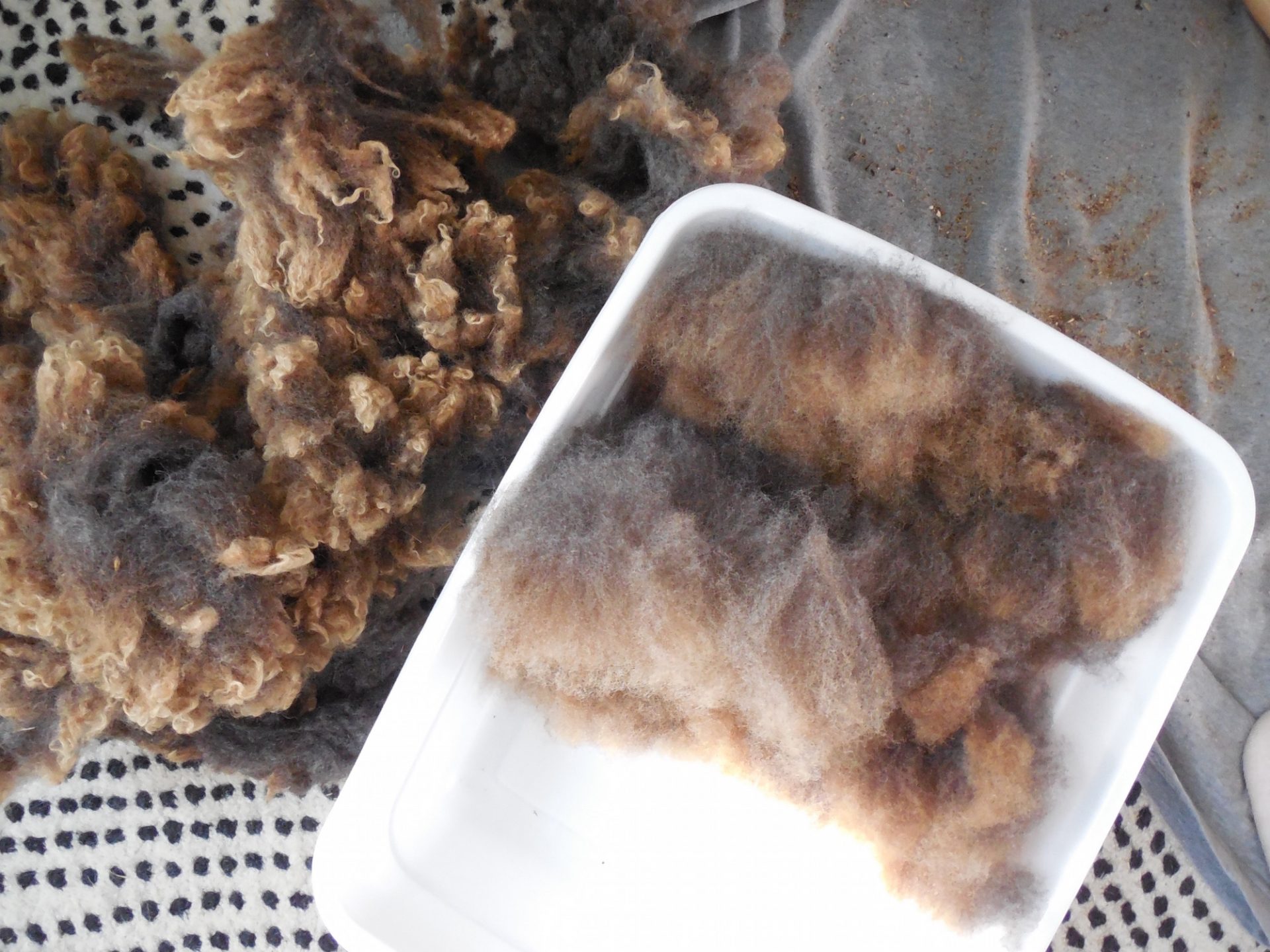
The year ended. Those final hours, were in fact, quiet productive. Hours of spinning and spending quality time with some Harlequin fleece before and in between playing games and enjoying food and desserts with my family – my husband and daughter. That’s a pretty darn great day in my book. Truly a good one – New Year’s Eve 2020 is right up there as one of the best I’ve ever had. All the basics (health and wool included) and good company, what more could anyone ask for.
End of Year Cram successes, albeit small: whittled down a one pound bump of Harlequin roving with four more ounces spun and plied into 2 two ounce skeins. I worked those pink rolags! Those six ounces of fluff are spun into a lovely yarn. I started hacking through some Teeswater locks. Really more like gentle snipping. So unfortunate I felted part of the one pound batch shown in my picture list two posts back. Sad, but still completely useable. The locks felted only at one end, which makes me think I just didn’t prep it properly before washing.
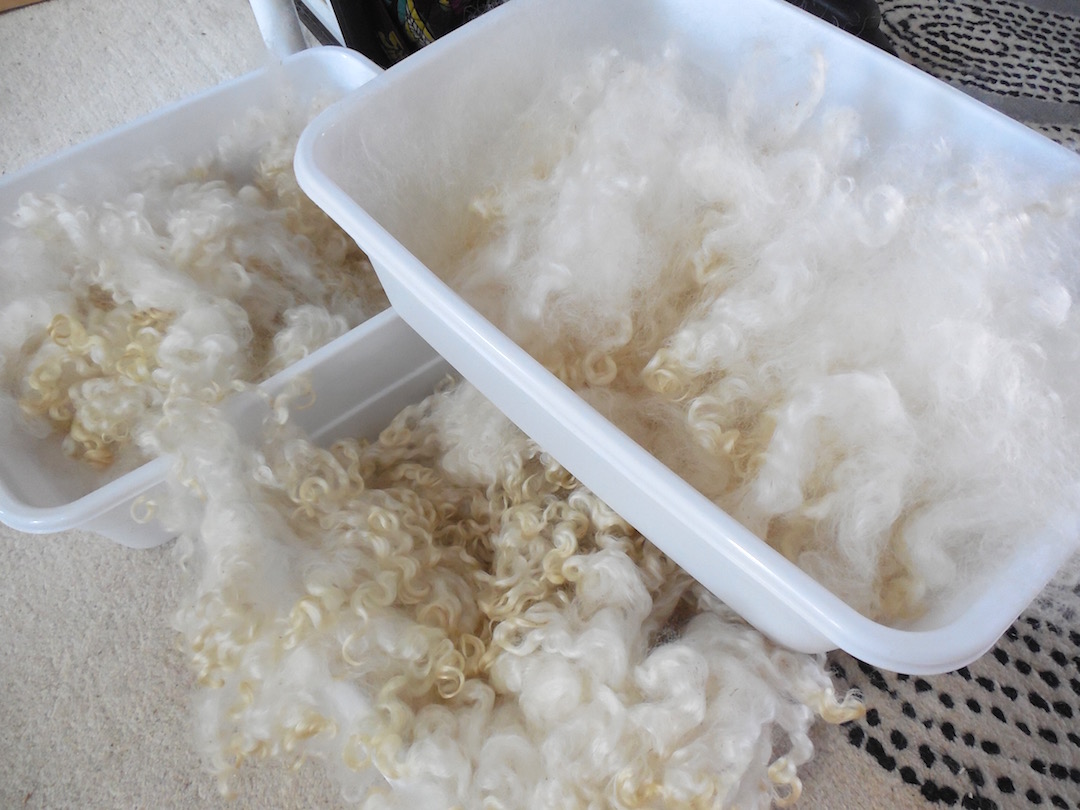
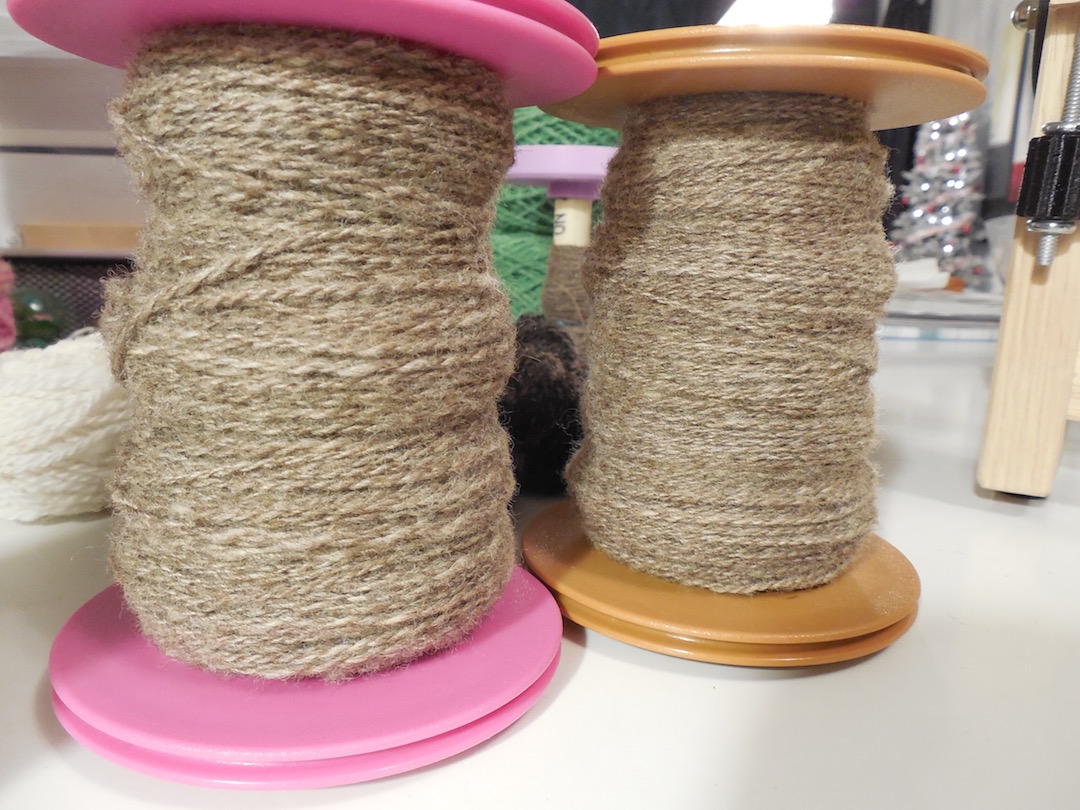
In 2020 I learned how to use support spindles and I started knitting! Knitting is an extra big one since I have been meaning to pick it up for many many years. I have done three whole swatches and entirely made one scarf. So much progress, lol!

Hello 2021, looking forward to learning new skills and honing the one’s I have. I am excited for all the wool and yarns to come. Happy New Year everyone!!
I just finished up the post from yesterday when I realized today is the two week mark until the end of the year. This is a good check-in day. Plus, I have some progress to show from yesterday.
I got the Harlequin/mohair plied. I do have some of the chunkier slubby stuff left on the bobbin. I’m not totally sure what to do with the left over. I should just spin a little more of the thin singles, but with all that VM business, I’m hesitant. I need to feel like things are moving along a little more quickly this second week of my End of Year Cram wrap-up. On the other hand, I don’t want to many random things unfinished just taking up bobbins. I already have a few of those awaiting my return.
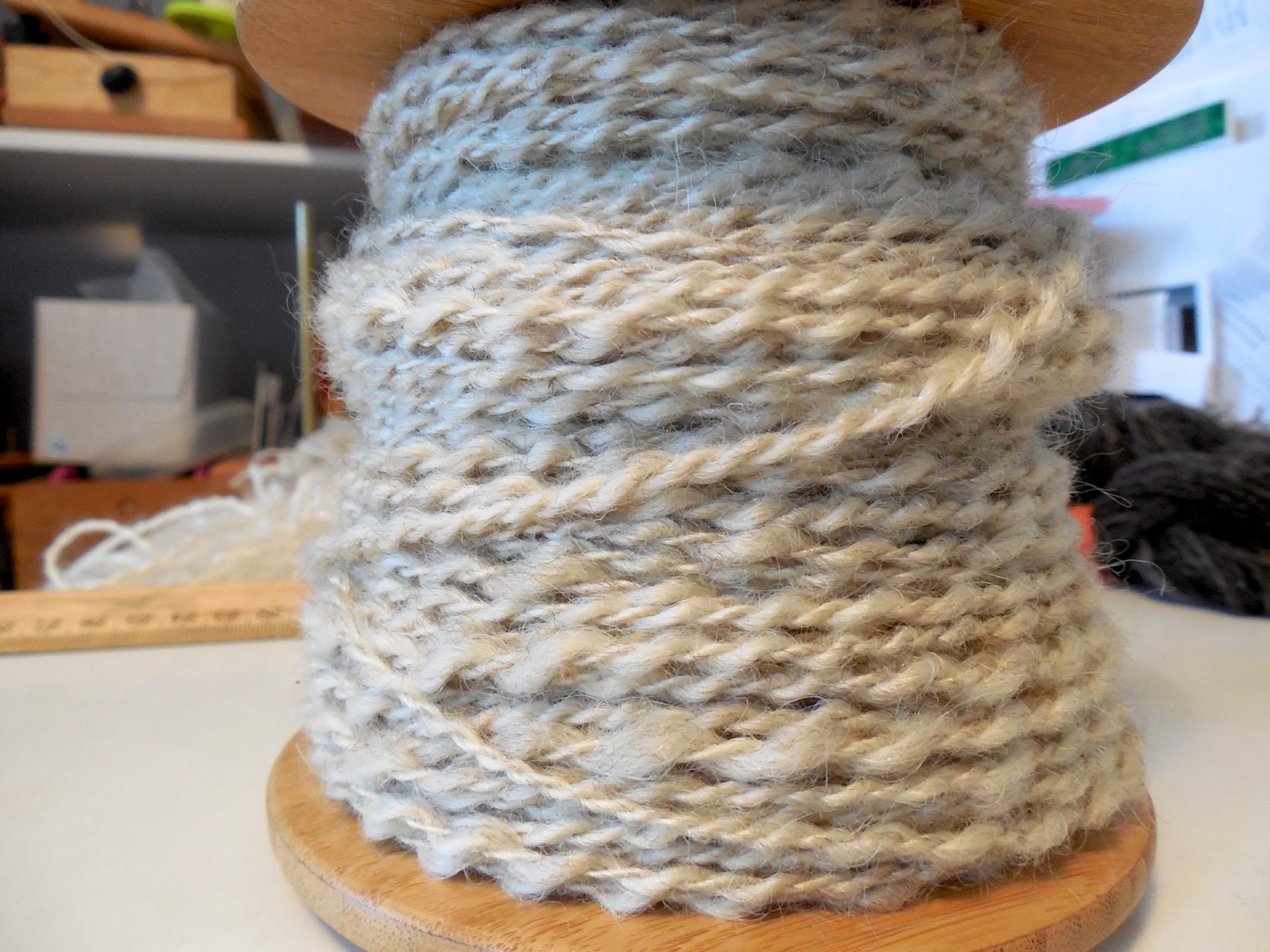
The pink rolags are all carded up! Two stacks ready to spin.
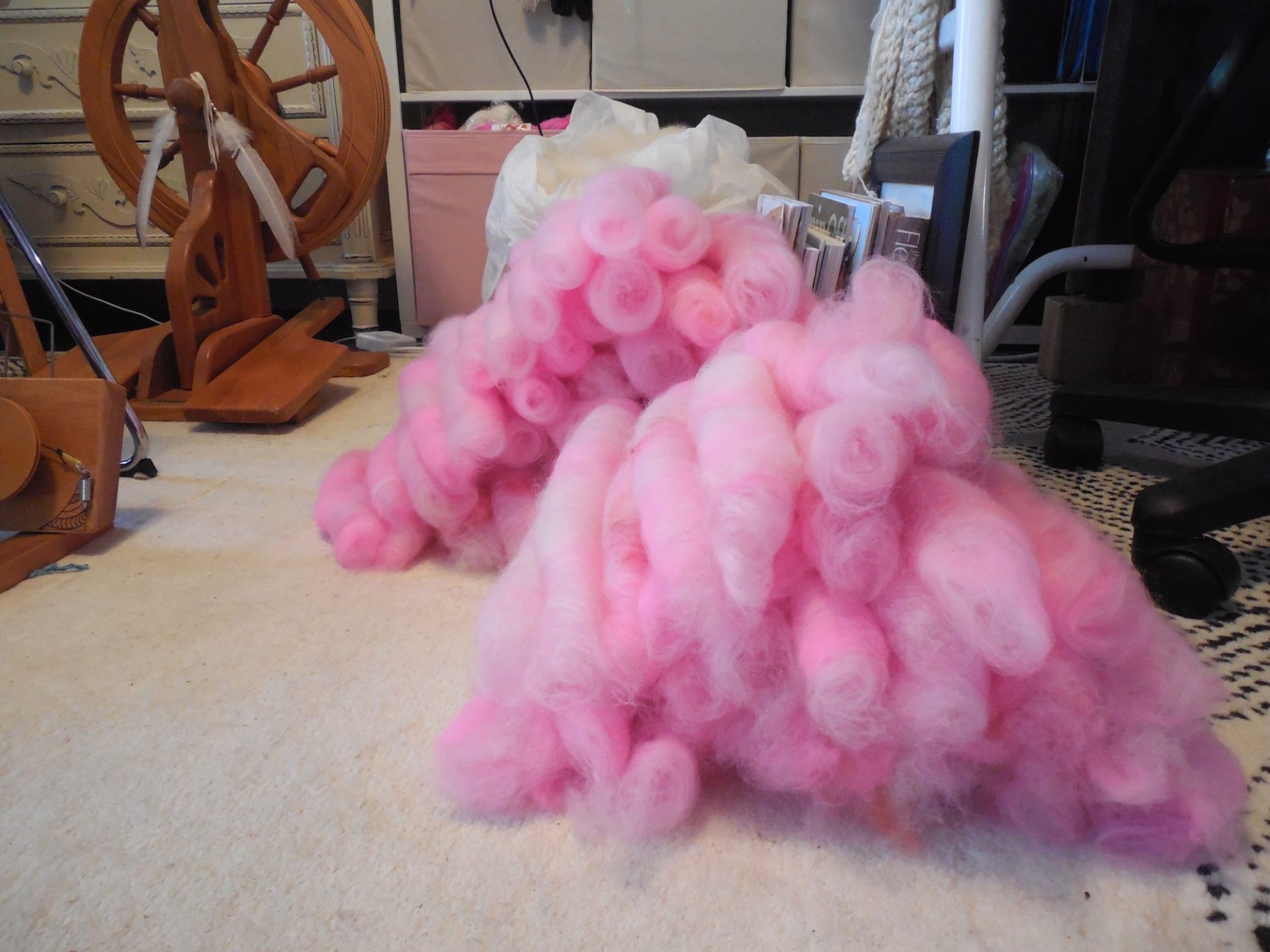
Should I count these last two mini spins? They are both sample spins for larger projects, but also for drum carder testing. Jacob was last week, Harlequin day before yesterday.
The Jacob was to test an old drum carder borrowed from a guild member – for fun and curiosity. This Jacob is on my End of Year Cram list. (It is one of the wools in the middle pictures in the previous post.) So, yeah, it should count.
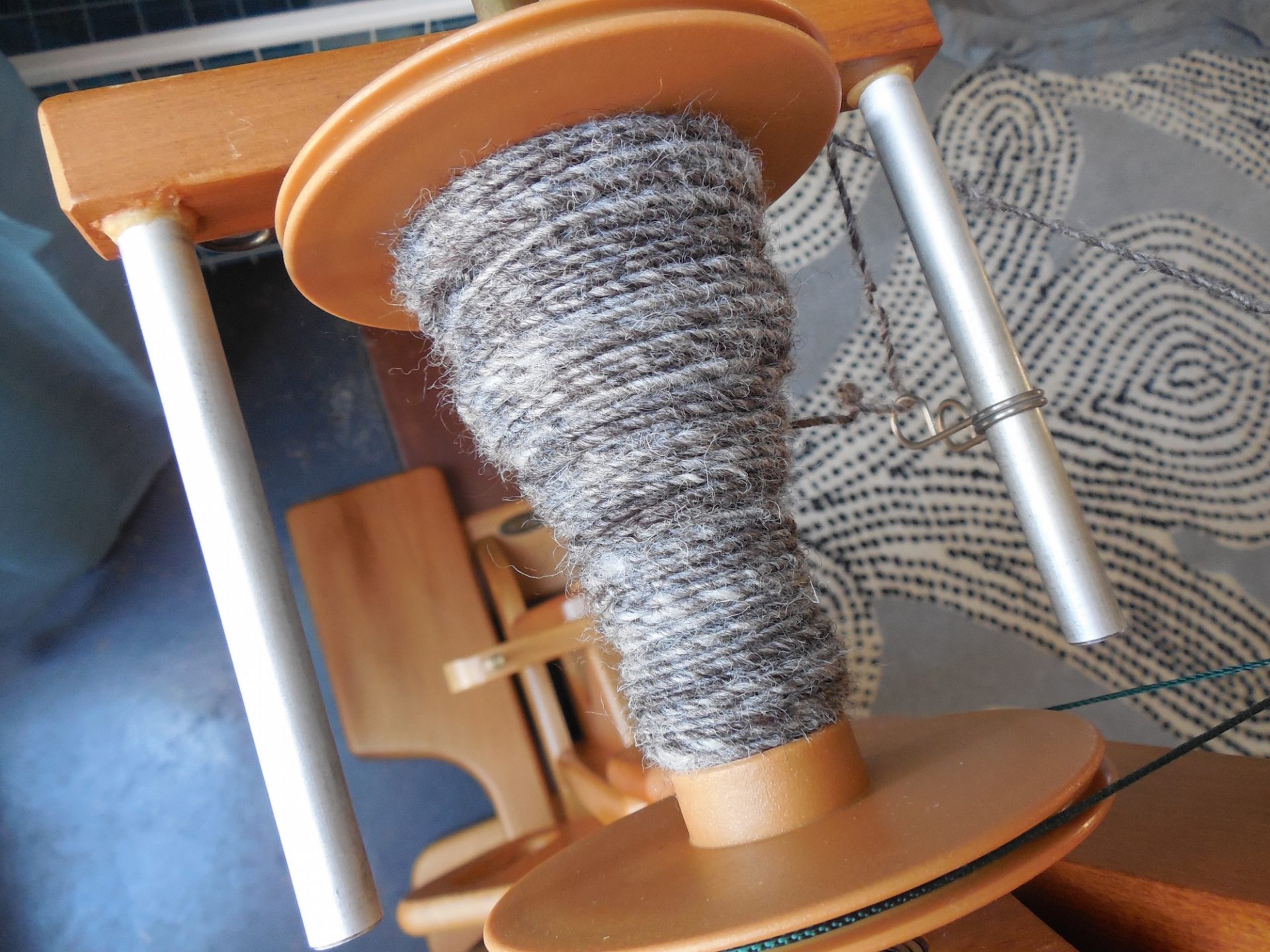
One ounce of Harlequin flicked and run through a new-to-me drum carder I just got from Ravelry Spinners Marketplace. It’s a Howard Brush fine fiber carder at 190 tpi. This was not on my radar, in fact the wool (even though I do have several of these fleeces) isn’t even in my fiber collection. I borrowed it from another guild member so we could compare each others washed and worked Harlequin fleece. This one doesn’t count.
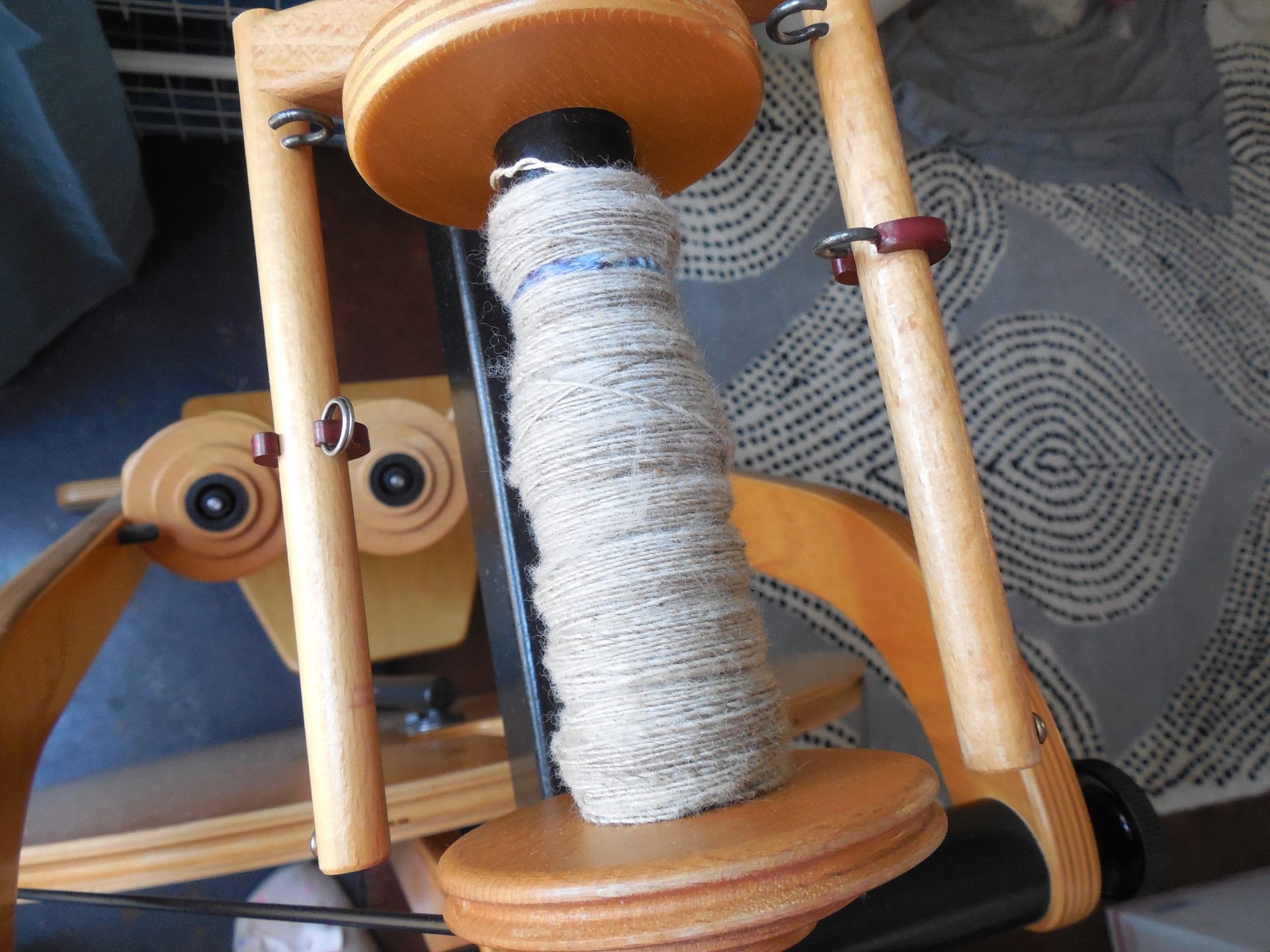
More to come.
A quick check-in along with some fiber pics. A week and three days ago, I posted about an end of year wrap up on fiber projects. How great it would be to get a few things finished before January. January is usually my wrap up month, but this year, given the virus, I thought why not get some things done in December.
I have so many projects started. Not being that organized at the moment, I didn’t come up with a specific written list for the last three weeks of this month. Using fiber that’s been sitting around the longest makes sense for piecing together a mental list. Looking around my studio …
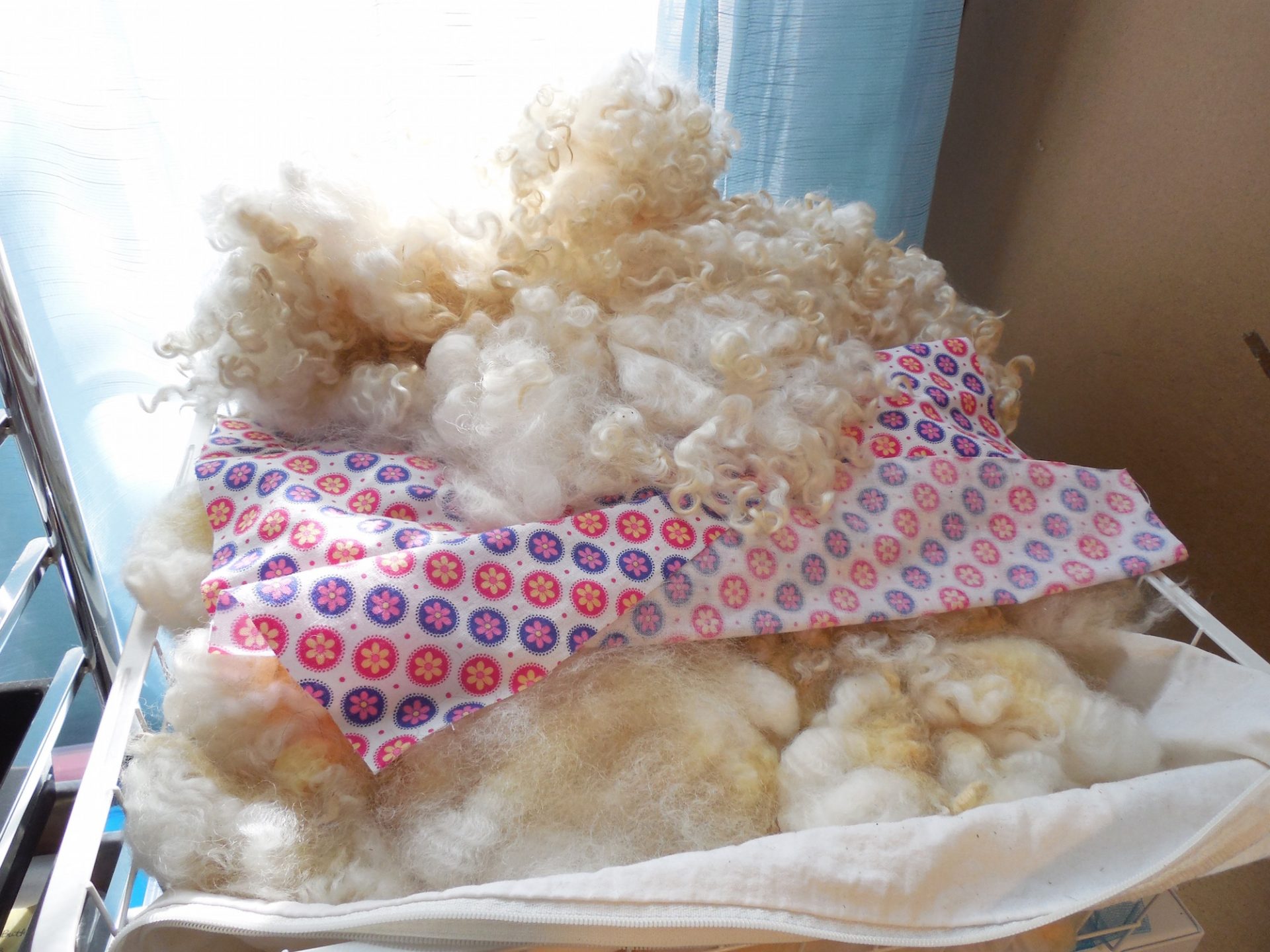
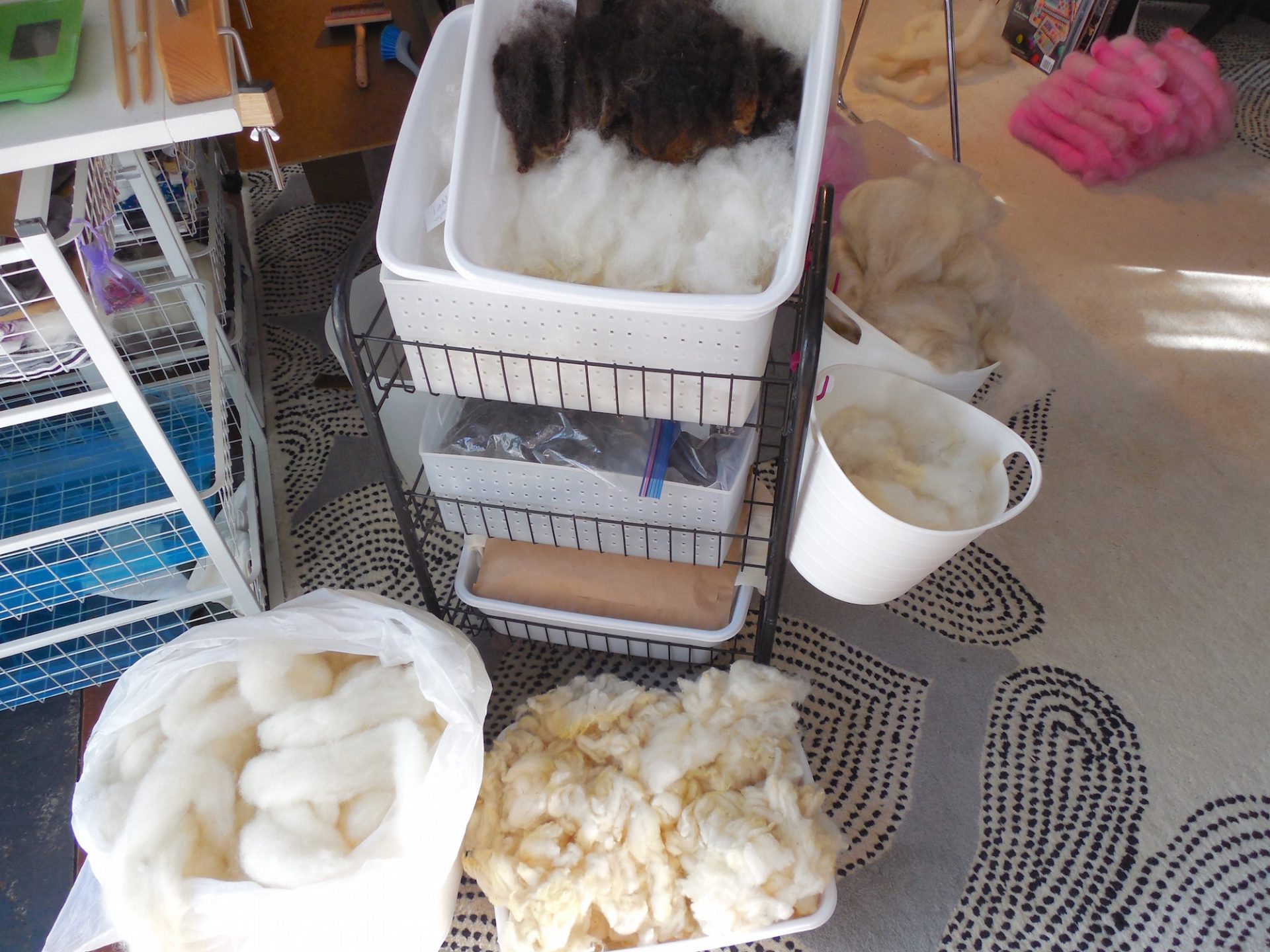
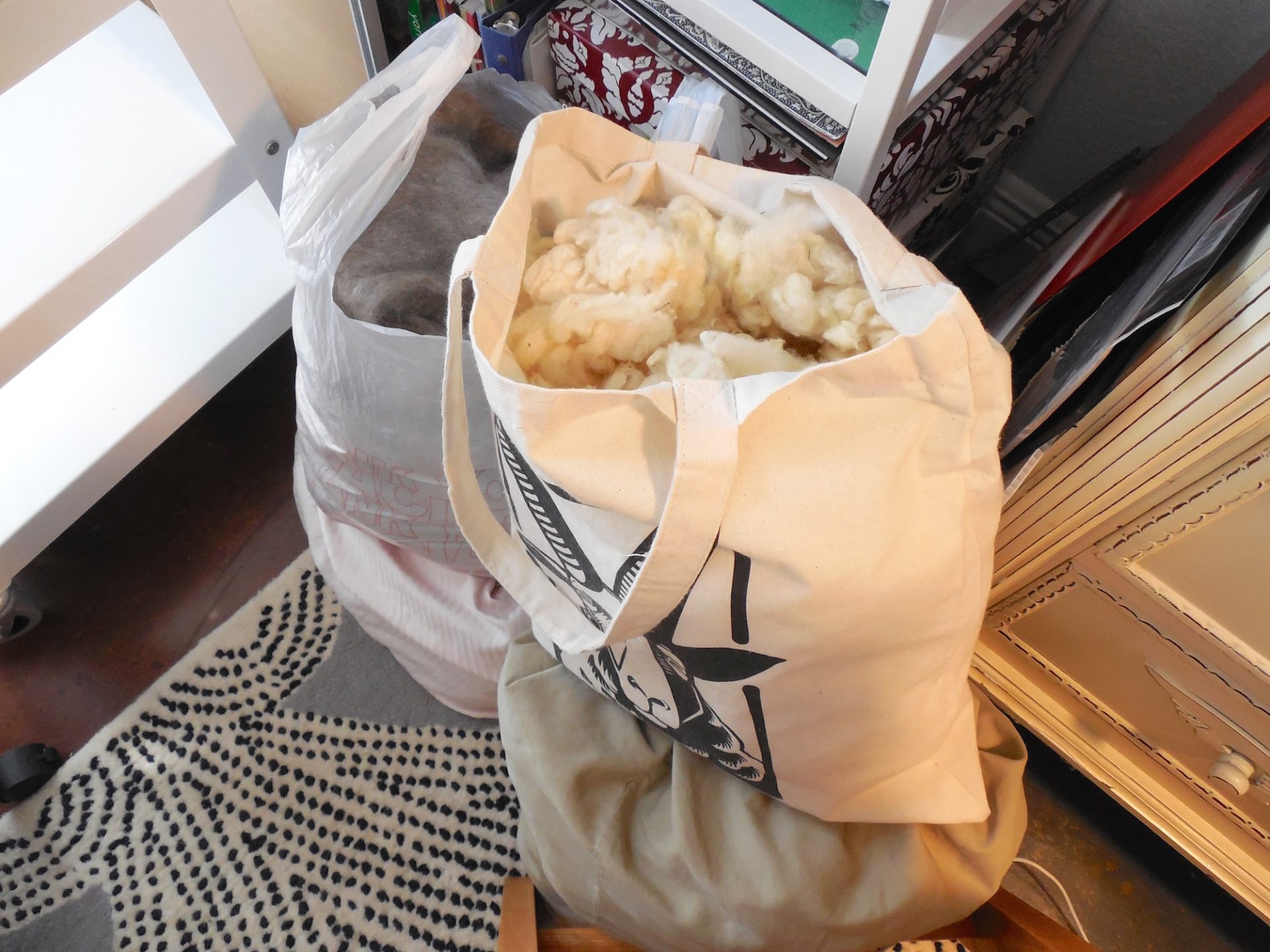
A list in pictures! I like it. Above pictures are a good portion of my currently in progress fiber To-Do’s. Basically in the order I should work on them. That Coopworth fleece has been sitting around the longest (since last year) – because I’m saving it to make a throw blanket for myself. That ALWAYS gets pushed to the bottom of the list of things to do. The Teeswater sitting on top of the Coopworth is roughly half a pound of the one pound washed of the 7 pounds raw that I got early summer this year. Teeswater – I love it, I hate it, I love it, I hate it…
Middle picture is where I actually started last week. I count seven different wools plus those pink rolags sitting on the floor in the back. I started with the round bin hanging on the right toward the back. That’s a Harlequin/mohair mix from sheep and goats in Smithville, Texas, milled into roving at Independence Fiber Mill. That is actually one of my most recent fiber purchases, but I was super eager to dive-in.
Last picture is pillowcase & bag of Southdown (washed last month), 1 bag of gray Harlequin/mohair roving, and last bag unknown (I need to take a peek inside). All piled neatly near my spinning wheel within the last month or so.
10 days and only 5 ounces later… I finally got all the Harlequin/mohair on the bobbins. I guess I should keep in mind for future planning that this is 5 ounces of 1 pound I bought. I am starting with 5 ounces to get a feel for this fiber. I wasn’t entirely sure how I wanted to spin the bulk of it. Or if I wanted to do several different types of yarn. Get a feel for it, I did. I spent at least 3 or 4 times the spin time picking out VM. VM, VM, VM! Must stay calm and work diligently in the midst of Vegetable Matter roving. Oh the challenge, the fine motor skills struggle of little bitty piece picking, the strain to see them all. The worst part is thinking you’re going to whip up a quick yarn, then coming to a sudden holt, for the most part, before it’s even begun. VM, the yarn blocker! *argh* *sigh* It happens… more often than you would think. I have come to think of it as part of the “charm” of working with wool. If there were no challenges, it would be dull. Some wools are just worth all the trouble. This one is going to be great, it’s Harlequin and mohair.
Feel free to share your projects in the comments. I love to hear about what everyone is working on – struggles, successes, mishaps.
Wow, it’s here, December 2020. I’m sure we can all agree we’d like to kiss this year goodbye and hope for some semblance of normality sometime in the coming year. But let’s not get to far ahead. We have three and a half weeks left of this unbelievable year. Right now, it’s cold and winter is upon us and it’s the perfect time of year to snuggle down and enjoy working those warm projects. I know things get busy with the holidays, but this year many of us will not be entertaining big parties or dinners or traveling or even going out shopping for the most part. It seems like that means we’ll have some extra time on our hands. Hmmm…what to do… well, seems like a good time to 1) paint some rooms in the house, and 2) spend more time working on fiber projects. Always a good idea to spend extra time working on fiber projects. Are you with me on this? Let’s see what we can get done in these last few weeks. Sounds like I just challenged myself….
Hats are my favorite crochet project! They are fun, and for the most part, easy. It’s a quick, functional, easy to wear project. Oh so many patterns to choose from or get creative and make your own. I like to purchase patterns. In fact, so much so, it could become a problem. I have to keep myself in-check. “Etsy and Ravelry how you make my life heaven and hell all at the same time!!” (*shakes fist at sky*) Making up things is great and I can certainly improvise or switch up a pattern or make size changes when they aren’t given. But, ya know, I just like to sit down and follow a pattern and crochet along easily without having to figure it all out. It’s enjoyable and things get done. And there are some really good designers out there. Honestly, I think my forte more lies is the realm of spinning.
Speaking of spinning!! My favorite topic. December (and every month really) is a great month to dive-in and get those spinning projects done. Got a couple sitting around? It’s December, do it, wrap up the year with a nice handspun yarn or two on the books.
I have a seemingly endless number of spinning projects in the works. I can’t even count them all right now. My studio has dishpans, random bins, and pillow cases of wool everywhere! It’s perfect!! I’ll be whittling away at some of those dishpans of wool. Let’s see how many I can get done before the end of the year. I’m going to start with some Teeswater and Harlequin/Mohair blend.
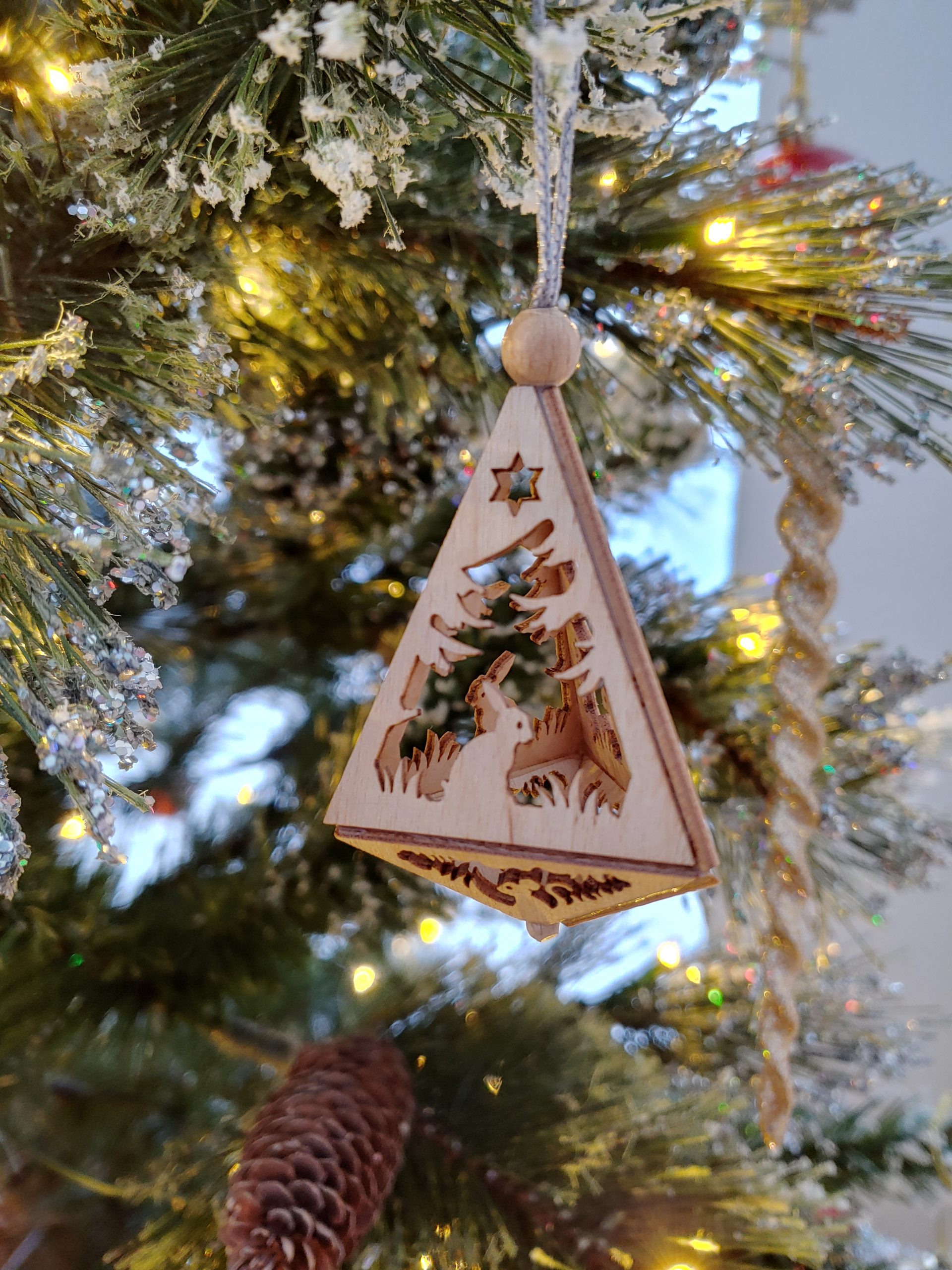
Decorating the tree is one of my favorite Christmas time activities.
I hope you all are having a safe and happy holiday time.
The most expensive sheep ever sold. Posted on CNN August 29, 2020.
https://www.cnn.com/2020/08/29/world/worlds-most-expensive-sheep-trnd/index.html
Last I wrote, Jacob is great, but didn’t thrill me. I implied the ol’ “it’s not you, it’s me” excuse to not explain anything. Even as I wrote it, I kept asking my self “but, why?”. Why do I feel like this? What’s not to be thrilled about? By all standards of measure, it’s a great fleece. What do I not like about this fleece and maybe Jacob in general? I can’t just go around thinking I dislike a breed without recognizing the reasons why.
I’m fairly new at hand processing wool – about 2 1/2 years of experience. In the world of wool and spinning is not a long time. Especially now, I feel like it’s important to sort out my thoughts about each fleece I process. Sorting out the more technical aspects is pretty easy. Using guidelines of the breed to assess what your working with really gives you an opportunity to learn the breed. Whether your fleece meets all the standard criteria or not, working raw fleece to yarn gives great insight into that breeds wool characteristics.
“Too medium” just keeps running through my head. But really, all that means is I need to put more thought into this. I need to discover just what too medium means. As of my last blog entry, I had only spun a very small sample of this Jacob fleece. It had been right after washing, before I flicked nearly the entire fleece. So often, from even a small sample spin, I get that “ok, I see what this wool is all about”. I really get to the heart of the characteristics – the length, the crimp, the softness or coarseness, the loftiness or silkiness – the combination of characteristics that make the wool special in it’s own right. This fleece did not want to reveal itself right away. Oh the mystery…
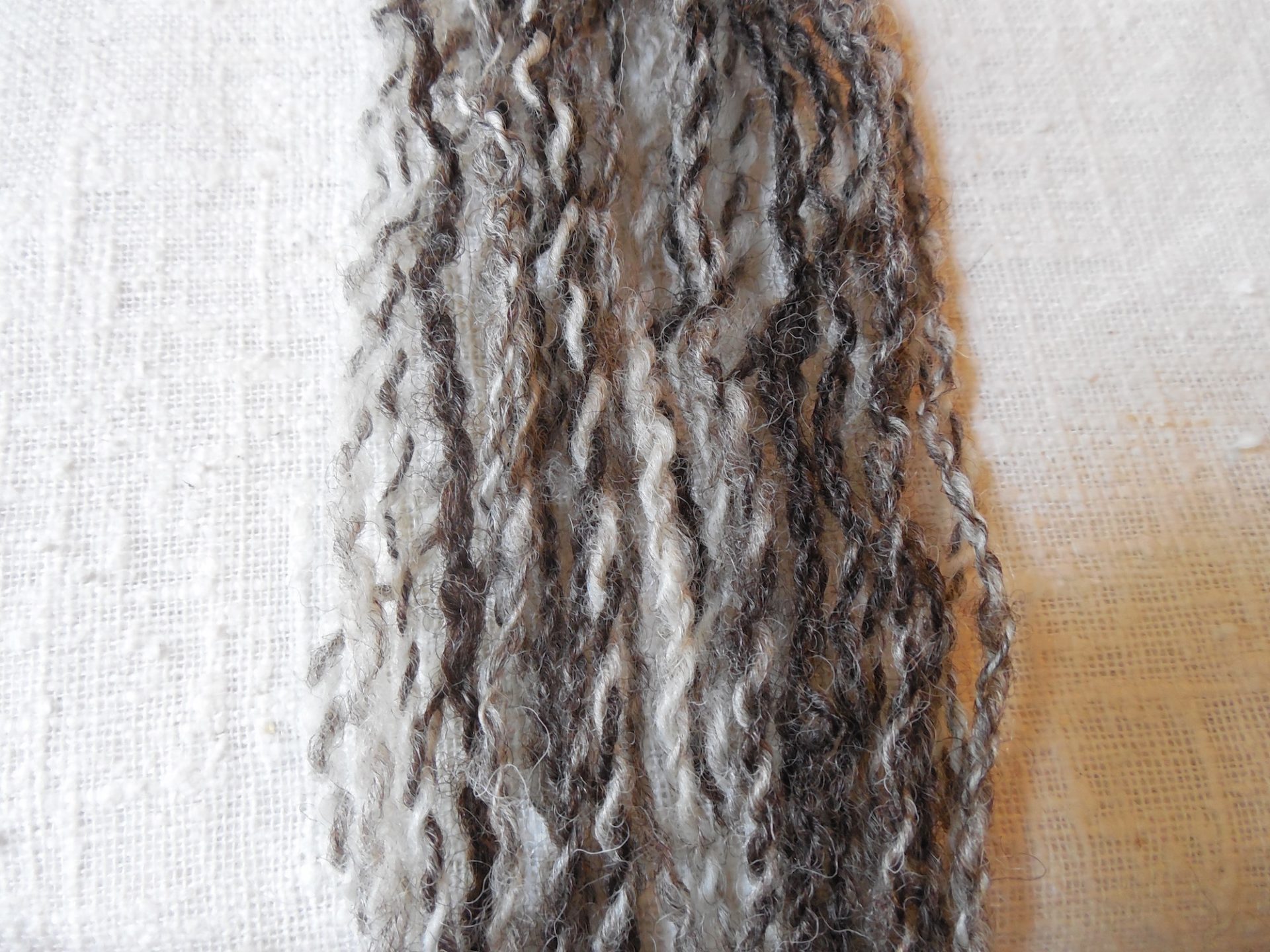
My first mistake was only spinning one little kind of sample. Making a judgement from that, is just not fair. I should know better and I usually do. Normally I sample spin several methods, pull them off the wheel and study them to see which one works best. I have now spun two more samples that are larger in order to get a better understanding. I can still say, this is a Medium wool. In fact, I can’t say that enough.
Flicking: it was deceptive. It looked as though it would flick easily. It was actually quite difficult to get through each lock. No, there was no matting at all. I experimented with two types of flickers and ended up using both throughout. Some of the locks needed a good whacking to loosen up the wool (again, even though it was not matted or felted). The fibers just held together on both the butt and the tip ends. Especially the tip end though. Even the little amount of VM wanted to stick to the fiber. All of my flicking sessions ended with soar and fatigued wrists and fingers.
Carding: this was a breeze. It went easily and smoothly through the drum carder. I have to say, the batts were quite lovely. I did one solid brown and one mixed color. I only put them through once so the multi-colored was purposely blocky.
Spinning: a nice experience. Spinning was pretty effortless. The wool was easy to manage. I spun one in a backwards draft with a sometimes long draw style just to see. The multi-colored batt was spun short forward. Both methods of spinning worked just fine, drafted consistently. Not too slippery and not too grabby. It was soft, but not too soft, had a sturdy handle with just enough grip.
As far as having similar characteristic to a down breed, well, maybe ever so slightly when spun from hand carded rolags, which was my first sample spin. After having just worked a Suffolk fleece, I’d have to say, “eh, not really super down-like”. Downs have sturdy hefty loft. This Jacob’s loft was a bit mushy. But Hey! That’s not to say something bad. Jacob loft is more delicate which can make for some very nice easy moving draping fabric. Also I’d be curious to try a slightly more mature sheep fleece to see if I’d get the same results. Remember, this is a yearling fleece.
The resulting yarn from any of these spins – worsted, semi-woolen, woolen – would work well for all different kinds of projects and garments.
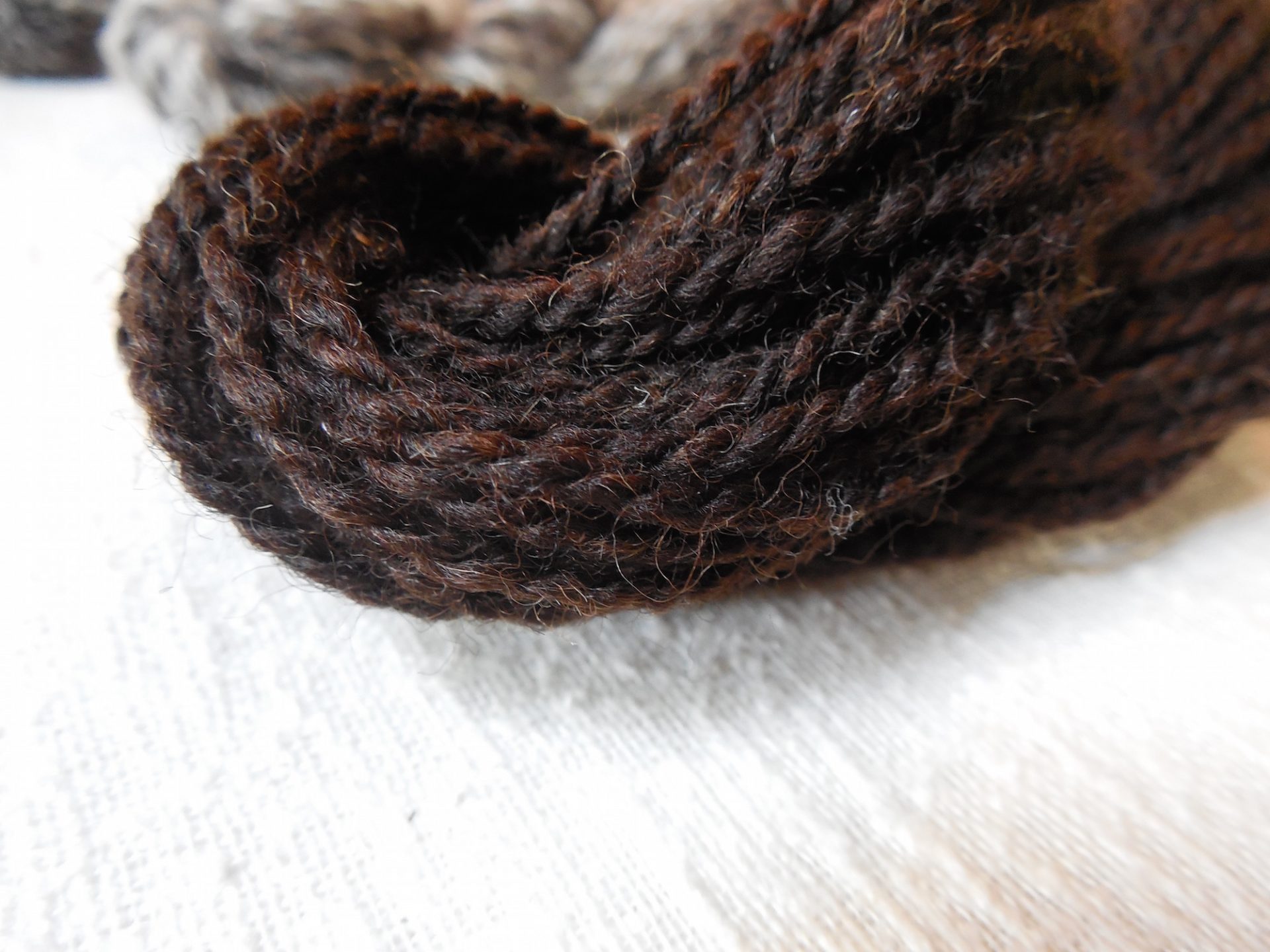
The upside: The dark brown is a rich color that in so very pretty. That dark contrasted with the white really creates a nice pop of color on the multi-colored yarn. You could really get a good variety of color blends with a Jacob fleece. The soft but sturdy nature and medium/low elasticity really makes this yarn very versatile. I am happy with the resulting yarns. My favorite from this fleece is the semi-woolen. Just enough squish to be ultra cozy.
The downside: Obviously, the joint fatigue I experience was a big downer. The VM was hard to get out which means 1) I had to pick at it after flicking, basically it turned into a whole extra step in the processing, 2) it takes a lot longer to get to the fun part of spinning it.
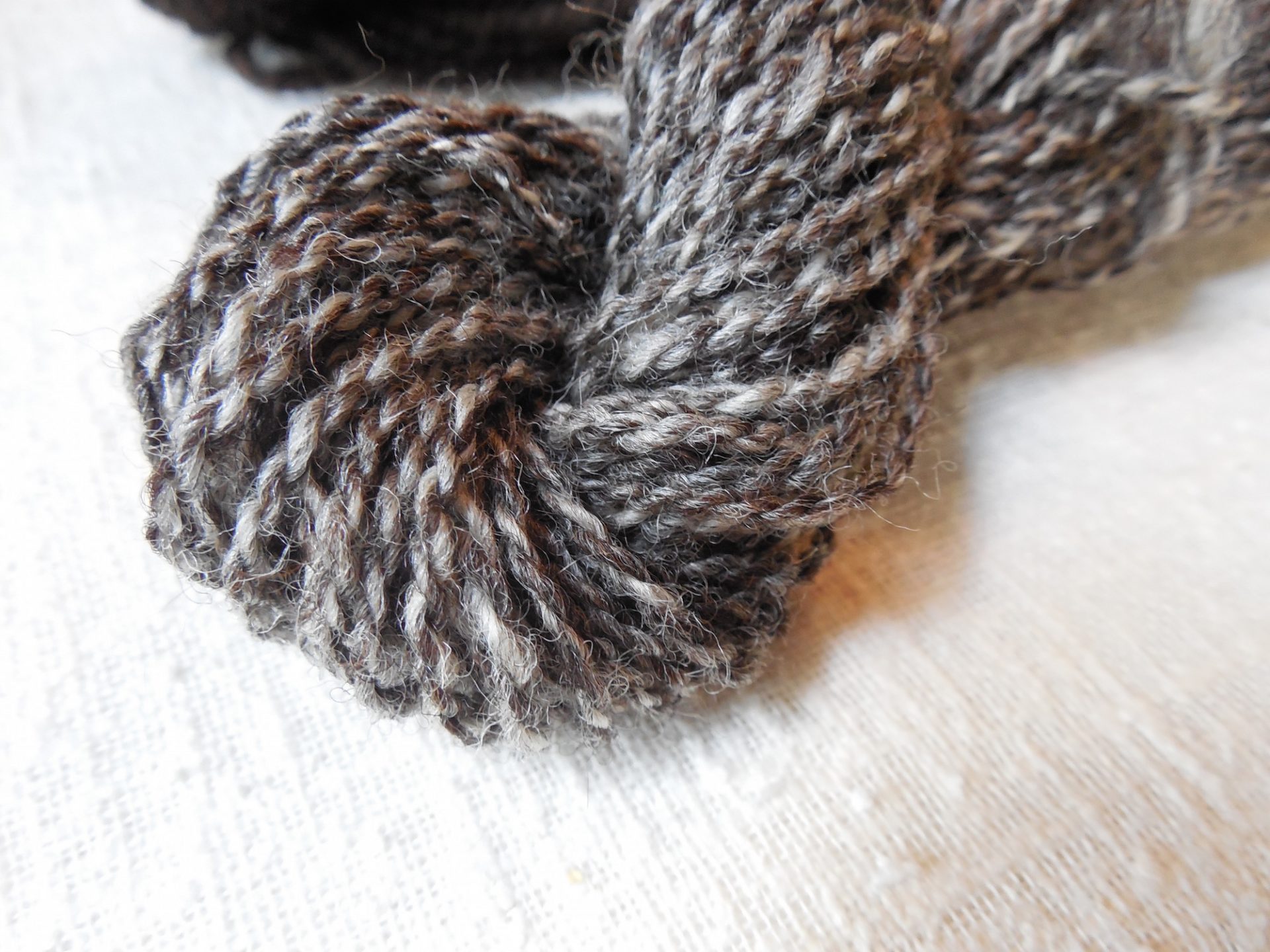
My wow moment did not come until the very very end. After I spun up both of the last samples, took a good look, I finally realized how pretty and functional Jacob yarn is. So often there is an “ah, I love X about this wool” moment early on. When that didn’t happen, I think I unconsciously moved on to my next fleece. Which, by the way, I had just washed. I believe my excitement for the next fleece played a part in my lack of enthusiasm for Jacob. Chalk it up to bad timing. While it’s still not at the top of my list, I like and have a great respect for Jacob. I have come to appreciate the qualities of this wool. It is a nice spin, nothing to technical or annoying about it. The final yarns are quite beautiful.
Have you ever come across a fleece that is captivating? It pleases your wool senses. It inspires possibilities. It begs to be handled. You love it so much that, after washing, you diligently check on it every hour or so to see if it’s dry yet. Deep inside you know it’s really just an excuse to gaze upon it’s loveliness just a few more minutes. The hand, the crimp, the color… the everything…too wonderful for words.
So, Jacob… um…well.. Jacob didn’t do that for me. Don’t get me wrong, it’s great. It’s a good breed with good sturdy wool. It just didn’t thrill me like I thought it would. High expectations (and lack of doing my homework) is so often a downfall. I got this nice fleece from a farm in New York. It is a yearling fleece! The staple length is 4 to 5 inches which falls right into the expected 3″ to 7″ range. It washed up nicely with 3 washes and 3 rinses. It has a nice balance of dark and light colored wool being a piebald (white with dark spots).
Jacob’s have medium soft wool. This one is, for the most part, pretty soft, which you would expect from a yearling. After washing, I dug into a section to start getting a feel for the wool, it was riddled with kemp. Ugh, I was confused and a little worried. Visions of limited-use skeins flashed before my eyes. Oh dear!
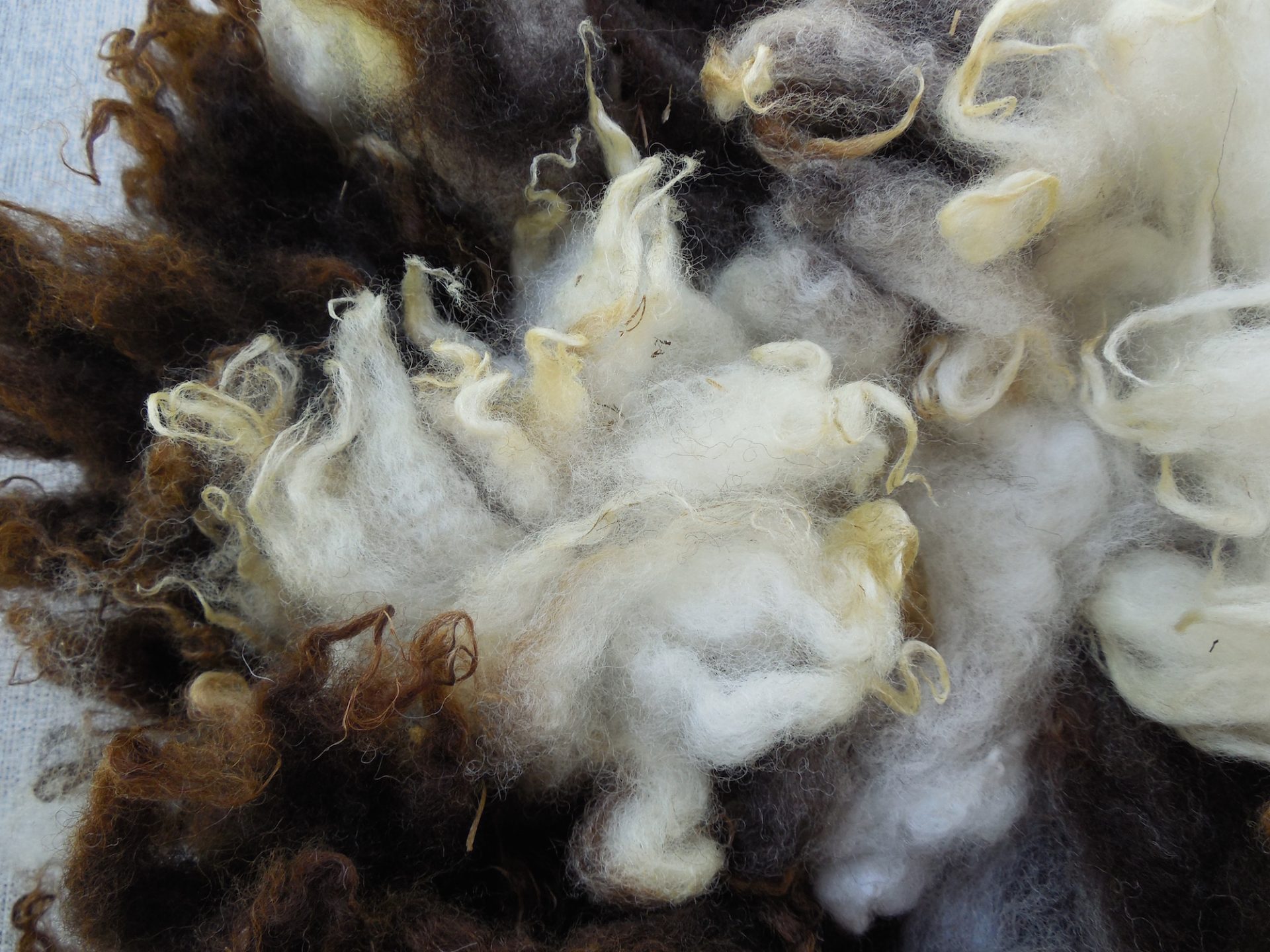
Further investigation revealed it was just that one little area with kemp. Oh, thank goodness! Regarding kemp, I have since read two different things. One, it’s common for Jacobs to have kemp. Two, another source said there should be little to no kemp. Huh. The length is more than great on this fleece. It ranges from 4″ all the way up to 6″ with the bulk of it in the 5″ range. Another common acceptable Jacob trait is varying lengths of wool on each sheep. Often the darker wool is shorter. Jacob fleece is also know to have a nice open structure and light in the lanolin department. It has a down-like quality even thought it is not double coated. It fluffs up with lots of spring when spun. The micron range for the breed is 26-36.
Oh, I almost forgot, one of the main characteristics is the horns. Jacob are polycerates. They have 2 to 6 horns.
A brief history: These charming small framed sheep come from England where they have been very popular for centuries. Beyond the most recent centuries, it is unclear of the original original decent. Some think maybe the area of Syria. Today there are British Jacobs and American Jacobs. Jacobs were imported to the US during the mid 1900’s.
The British decided to breed Jacobs for an even fleece and larger overall body structure. Jacobs in the US have been breed to enhance the quality of wool but leaving other original characteristics the same.
Jacobs are a Heritage or primitive breed. In the United States, they have been put on The Livestock Conservancy conservation list, currently at a “Threatened” status.
Small batches of washed locks and flicked locks are available in my Etsy shop as of the publishing of this blog entry.
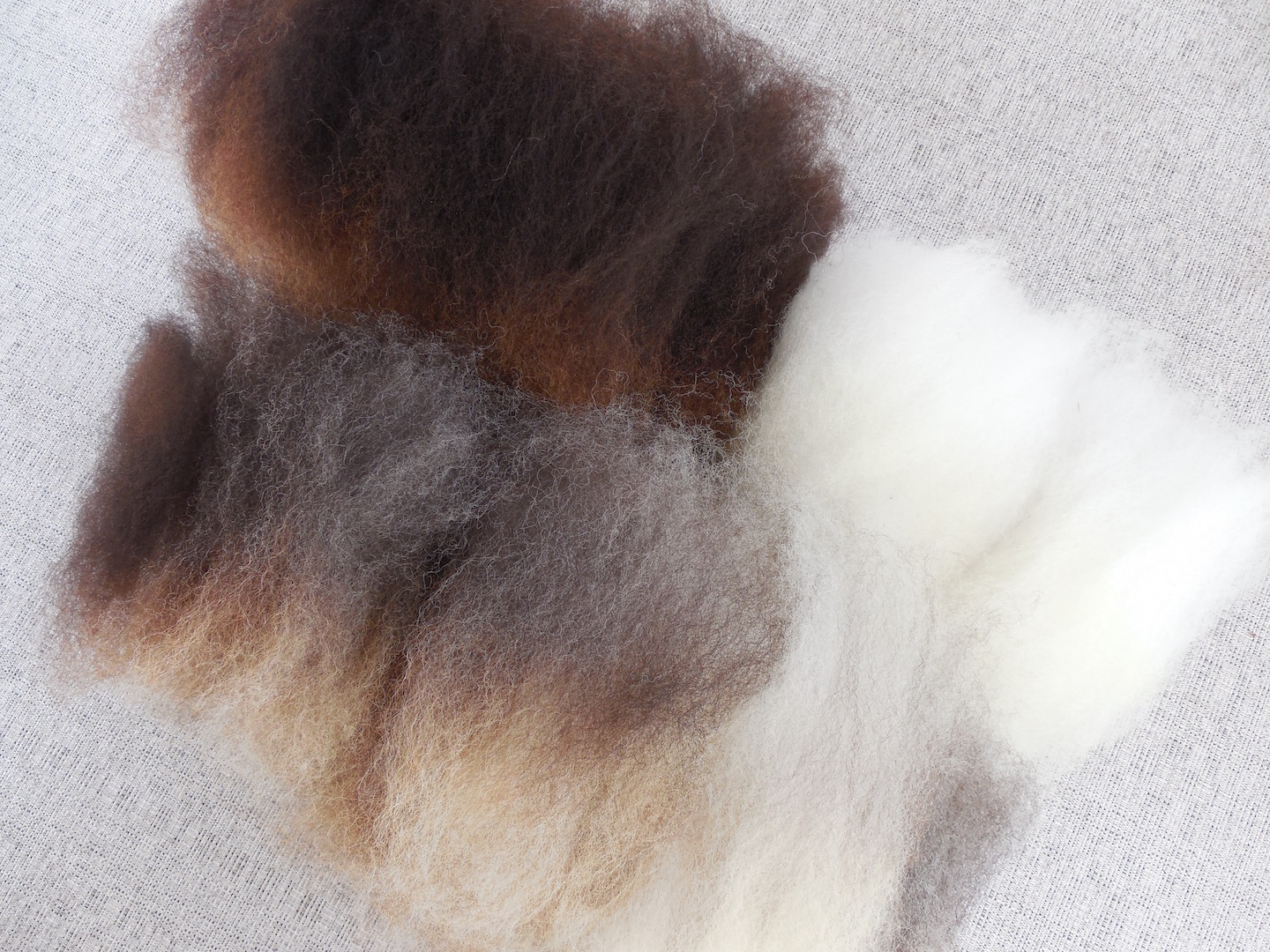
Today is the first of two Rest Day’s for the Tour de France riders. It marks the end of the first week for the well known bicycle race that is a grueling three weeks long. In all, it’s 23 days (2 day off). Each day of riding is a stage, there are 21 stages with 2 challenge days…as if riding for 3 weeks isn’t enough of a challenge. In all, the participants from all around the world will ride over 2,000 miles. Here is an informative (and easy on the eyes) website to read more about it – https://www.bbc.co.uk/newsround/18769169
Ok, that race originated in 1903. The Tour de Fleece made it’s debut in 2006. Star (https://www.ravelry.com/people/starathena), a knit designer and spinner, came up with this wonderfully clever way to bring spinners and fiber lovers from around the world together for three weeks of spinning. Tour de Fleece which is hosted on Ravelry – https://www.ravelry.com/groups/tour-de-fleece – coincides with the Tour de France. All the same stages, same rest days, same challenge days. There are official teams and unofficial teams. There are diehard teams and teams that spin for fun. Many use it as a motivator to kick start spin projects and use up fiber stash, as well as finish those spins that have been nagging since last TdF. It’s open to all spinners new and experienced. For the motivated and serious, it can challenge your strength, stamina, and will power.
This year, of course, there was a delay on the original race because of COVID19. It normally happens in July. This year’s new race dates are August 29th to September 20th. It was decided that Tour de Fleece would go ahead during the original race dates, PLUS do a 2.0 during the actual race.